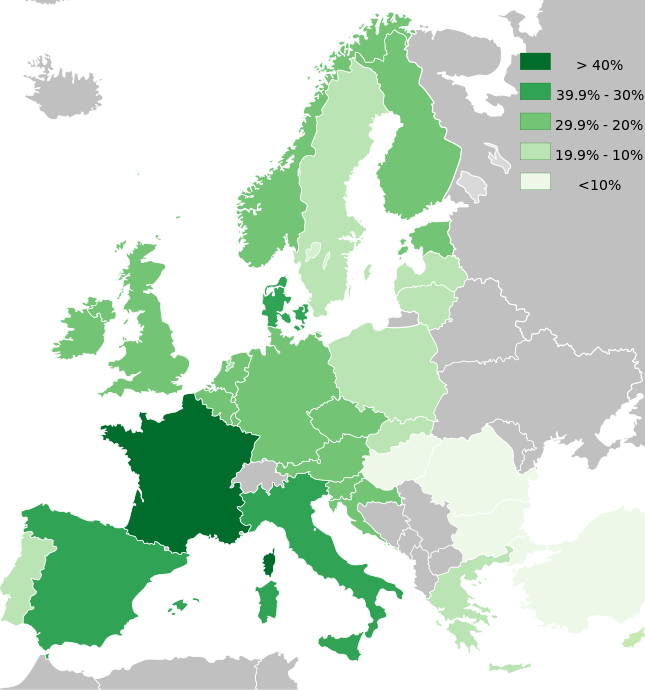Table
- Age range is the range the data computation is based on.
- Asterisks (*) are for locations with "Cannabis in LOCATION" links.
| Location | Geographical area | Year | Age range | Males | Females | Total | Ref. |
|---|---|---|---|---|---|---|---|
| National | 2007 | 14+ | 33.5 | [4] | |||
| National | 2020 | 15–64 | 24.8 | 20.6 | 22.7 | [1] | |
| National | 2018 | 15–64 | 28.1 | 17.3 | 22.6 | [1] | |
| National | 2017 | 16+ | 27.0 | 12.0 | 19.5 | [5] | |
| National | 2020 | 15–64 | 9.5 | 7.8 | 8.7 | [1] | |
| National | 2021 | 16+ | 58 | [6] | |||
| National | 2014 | 12–64 | 31.5 | [7] | |||
| Beijing and Shanghai metropolitan areas. | 2002–3 | 18+ | 0.3 | [2] | |||
| All urban areas of the country (approximately 73% of the total national population). | 2003 | 18–65 | 10.8 | [2] | |||
| National | 2019 | 15–64 | 28.8 | 16.9 | 22.9 | [1] | |
| National | 2019 | 15–64 | 21.5 | 7.1 | 14.1 | [1] | |
| National | 2021 | 15–64 | 31.1 | 21.1 | 25.9 | [1] | |
| National | 2021 | 15–64 | 44 | 32 | 37.9 | [1] | |
| National | 2018 | 15–64 | 30.8 | 20.3 | 24.5 | [1] | |
| National | 2018 | 15–64 | 29.8 | 21.3 | 25.6 | [1] | |
| National | 2021 | 15–64 | 54.9 | 39.9 | 47.3 | [1] | |
| National | 2021 | 15–64 | 38.9 | 30.2 | 34.7 | [1] | |
| National | 2015 | 15–64 | 15.8 | 6.3 | 11 | [1] | |
| National | 2019 | 15–64 | 8.4 | 4 | 6.1 | [1] | |
| National | 2019 | 15–64 | 29.5 | 19.3 | 24.4 | [1] | |
| National | 2002–4 | 21+ | 11.5 | [2] | |||
| National | 2017 | 15–64 | 39.1 | 26.4 | 32.7 | [1] | |
| Four metropolitan areas (Fukiage, Kushikino, Nagasaki, Okayama). | 2002–3 | 20+ | 1.5 | [2] | |||
| National | 2020 | 15–64 | 22 | 8.2 | 15 | [1] | |
| National | 2002–3 | 18+ | 4.6 | [2] | |||
| National | 2021 | 15–64 | 20.7 | 6.8 | 13.7 | [1] | |
| National | 2019 | 15–64 | 27.8 | 19.6 | 23.3 | [1] | |
| National | 2013 | 15–64 | 6.7 | 2 | 4.3 | [1] | |
| All urban areas of the country (approximately 75% of the total national population). | 2001–2 | 18–65 | 7.8 | [2] | |||
| All urban areas of the country (approximately 80% of the total national population). | 2001–2 | 18–65 | 7.8 | [2] | |||
| National | 2021 | 15–64 | 35.7 | 23.9 | 29.8 | [1] | |
| National | 2004–5 | 16+ | 41.9 | [2] | |||
| 21 of the 36 states in the country, representing 57% of the national population. | 2002–3 | 18+ | 2.7 | [2] | |||
| National | 2024 | 16–64 | 35.0 | 24.0 | 30.0 | [8] | |
| Seven cities (Lima, Trujillo, Tacna, Arequipa, Ayacucho, Tarapoto and Iquitos) | 2003 | 12–64 | 10.3 | [9] | |||
| National | 2018 | 15–64 | 16.4 | 7.7 | 12.1 | [1] | |
| National | 2016 | 15–64 | 15.6 | 6.6 | 11 | [1] | |
| National | 2019 | 15–64 | 8 | 4.3 | 6.1 | [1] | |
| National | 2019 | 15–64 | 23.4 | 10.6 | 17 | [1] | |
| National | 2018 | 15–64 | 24.7 | 16.5 | 20.7 | [1] | |
| National | 2003–4 | 18+ | 8.4 | [2] | |||
| National | 2022 | 15–64 | 48.8 | 32.9 | 40.9 | [1] | |
| National | 2021 | 15–64 | 21.9 | 13.1 | 17.6 | [1] | |
| National | 2017 | 15–64 | 5.4 | 0.2 | 2.7 | [1] | |
| National | 2002 | 18+ | 6.4 | [2] | |||
| National | 2021-22 | 16–59 | 31.2 | [10] | |||
| National | 2010–11 | 15–64 | 24.0 | [11] | |||
| National | 2010–11 | 16–64 | 26.7 | [11] | |||
| United Kingdom overall | 2006 | 16–59 | 30.2 | [11] | |||
| National | 2023 | 18+ | 49 | [12] |
